by Barry Rudolph
|
Softube Valley People Dyna-mite
by Barry Rudolph |
|
Sweden-based Softube does their magic trick again with another excellent plug-in processor modeled after a classic piece of outboard gear. This time it's the single rack space, dual-channel Valley People Dyna-mite limiter/expander/gate. This is the first plug-in model of the Dyna-mite unit and the first and only software recreation of the Dyna-mite officially endorsed by Valley People. I found it everything and more than the original.
The original Dyna-mite was an 80's-era unit shunned by a lot of engineers who didn't take the time to learn all the amazing powers of this diminutive processor. It was a "hidden treasure" in the outboard rack and revered by those who knew how to use it as their mixing and recording secret weapon.
Softube's Dyna-mite fully emulates Valley People's proprietary VCA and their Anticipatory Release Computation scheme. ARC analyzes the input signal and lengthens the release time on a "as needed basis" to prevent low frequency waveform distortion and rapid gain pumping caused by the extremely fast release time settings Dyna-mite is capable of.
Dyna-mite comes as a Native plug-in only. Available in RTAS, VST and AU versions for Macs (OS 10.4 and higher) and PC (Windows XP and later), it runs as either a stereo or mono instance and in sessions with sample rates up to 192kHz. It's iLok authorized and supports sidechaining in host DAW systems that allow for that mode.
I downloaded and installed Dyna-mite into my Pro Tools HD 3 Accel (ver 7.4) rig I have running in a PPC Quadcore (OS 10.4.11). All went well the very first time and the plug-in (lucky for me!) has buttons on the GUI for accessing both a Quick Guide and the excellent manual. Furthermore, the bottom half of the GUI has a contextually sensitive help screen that changes whenever you touch a control or switch. However, since I now consider myself a newbie expert, I have not found out yet how to turn this feature off. Softube is polling their users to see if they think an on/off button for this help screen is a desirable update.
Controls And GUI
All numerical values in the GUI are clickable and adjustable with MAC users enjoying mouse wheel support for changing both up/down values and switch positions. Standard, fine parameter value adjustment--Apple Command key on MAC and Ctrl on PCs is also supported. Unlike the original two-channel hardware unit, the plug-in's stereo version shares all controls and processing across both channels. If this is a hitch for you, split the stereo track and insert two separate mono versions.
Threshold
The controls on Dyna-mite start on the left side of the GUI with the Threshold knob. Threshold has a range of -40dBv to +20dBv that, in these digital times, really means -60dBFS to 0dBFS. Limiting gain reduction is indicated on an eight-LED meter but, strangely, you cannot measure output level.
The Threshold knob controls both the limiter and expander/gate threshold levels. The simple fact that most of the controls on the original hardware unit are shared between the different processor modes probably confused a lot of engineers when they first used the old hardware Dyna-mite limiter. I have to admit that there is a slight learning curve with Dyna-mite--I couldn't just jump in and start cranking knobs around like another limiter plug-in. But the help screen and reading the manual set me right immediately.
Release
The next control is Release or the recovery time Dyna-mite takes to return from gain reduction back to unity gain. Variable from 50ms to 5 seconds for a change of 20dB, again the same knob controls both the limiter's release time and the gate/keying/expansion recovery time period as well.
Range
Range controls the amount of gain reduction--for both the limiter and expansion/gating modes. This also includes ducking (another form of more severe gain reduction) from an external keying input. On the hardware unit the Range setting was only available for the Expansion mode and it was expanded (couldn't resist that pun) to included the limiting mode on this plug-in--ain't software processor emulations great! To mimic the hardware in limiter mode, Range should be set to its maximum possible gain reduction of 60dB.
If you set the Range to 30dB and you have drum peaks with absolute loudest peaks hitting -40dB of gain reduction, you'll have three ranges or sections in which Dyna-mite processes differently. There will be no limiting at all below -40db; limiting with an infinity to 1 ratio from -40dB to -10dB (-30dB subtracted from -40dB); and no limiting again for all peaks above -10dB to 0dBfs. All sound -10dB or above--that would be transients or the attacks of a drum kit--will pass untouched while everything else will be squashed bringing up low frequencies, ambience and the internal detailed sounds of the kit.
Output
There is a range of -15dBv to +15dBv here and I found plenty of make up gain no matter what mode Dyna-mite was running in. It's interesting that there is an auto makeup gain while in limiter mode that follows the Threshold setting. This is one of the best auto makeup gain features I've seen in a plug-in--I rarely needed to adjust Output ever.
The Clip LED acts like the original unit and, as I remember, the original Dyna-mite got nasty sounding when in clip (and not a cool distortion either). But on this plug-in, you can go ahead and clip all day because the clip section acts as a kind of "brick wall" peak limiter. The sound quality is fine especially if you are only "redding" on transient peaks.
What Ratio?
Dyna-mite has infinity to 1 ratio in limit mode, a 2:1 ratio in noise gate or expansion modes, and 20:1 in the hard gate mode. These ratios are selected depending on the combination of the Detector source, Operating Mode and Detector Type switches.
Detector Sources
There are three possible detector sources: for most limiting jobs there is Internal (i.e. the plug-in is reacting to the actual track you are Dyna-miting); for ducking and keying effects there is an external source via the side chain; and the DS-FM filter position adds a high frequency shelving filter starting at 12-14kHz with a boost of up to 20dB by 18kHz. This is for compressing only the highs for de-essing or controlling loud cymbals in drum overheads or room tracks.

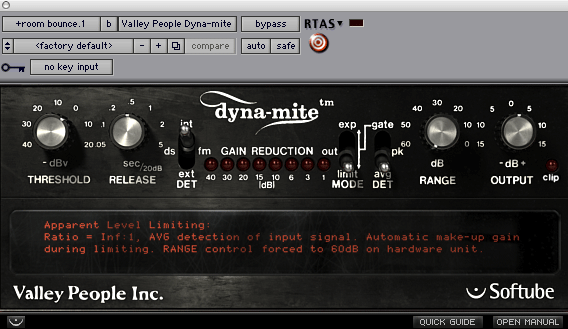
Operating Modes And Detector Types
Dyna-mite operates in either one of two modes switchable with the Mode switch. They are Limit and Expansion. It cannot do both modes at the same time but nobody said you couldn't follow a Dyna-mite set as an expander/gate with another one set up as a limiter. These two modes radically change in processing predicated upon which of the three Detector Types you choose.
Detector Types
The Average (or RMS) Detector Type is the slowest at about 1 to 15ms while Peak is much faster at 0.05ms (or 50 microseconds). Ratios in limit or expansion/gate modes are the same (as stated above) for either of these Detector Type attack time settings.
Changing to the Gate Detector Type changes the ratio to negative--or -20:1. For every 1 dB above the threshold setting, gain will be reduced by 20dB. Not just for soft gating, the Gate Detector Type is also for hard gating with a 20:1dB ratio. If Dyna-mite is set in limit mode and with the Gate Detector selected, the ratio changes from the more normal positive values to negative values for negative limiting. (More later on this bizarre effect)
In the Studio
A processor like Dyna-mite elicits (from me anyway) all sorts of wild and crazy ideas for sonic treatments. But first all I wanted to test it out working as the original was known for, it's forté: a utilitarian limiter good for any source.
Acoustic Guitar
I first tried it out on an acoustic guitar I had placed within a stereo room effect with a Lexicon LXP Native Reverb plug-in inserted on the track. I was not looking for a big squash here but only slight leveling to maintain a big sound. Using Dyna-mite help to fatten the acoustic minimally, keep it more consistent within my mix yet not "dirty up" or cloud its pristine sound.
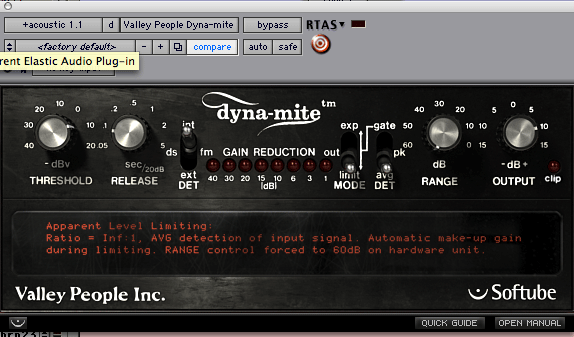 | |
| Dyna-mite GUI For Acoustic Guitar | Click Here For All Sound Samples |
Drum Room Mics
I had recorded this drum kit's room mics using a compressor already but when it came to mix it, the producer didn't think it sounded "belligerent" enough. How could I rough up the sound?
I set up Dyna-mite as a more radical limiter. So as compared to the acoustic guitar settings, I went for a lower threshold and increased the makeup gain. You can "radicalize" and effect the sound even further by selecting the Peak Detector Type and lowering the threshold setting.
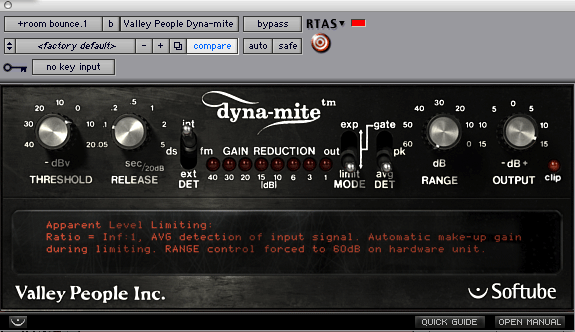 | |
| Dyna-mite GUI For Stereo Drum Room | Click Here For All Sound Samples |
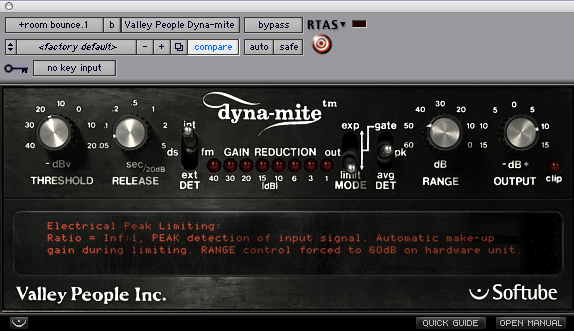 | |
| Rad Dyna-mite GUI For Stereo Drum Room | Click Here For All Sound Samples |
Negative Limiting--The "Organ Effect"
Softube calls the negative ratio setting the Organ Effect. To show off this sound I chose a Hammond organ part. With nearly the fastest release time possible, a high threshold, using the Gate Detector Type and a 10dB Range setting, I was able to add an attack sound to the organ part much like when the Percussive switch is used on the Hammond organ console. This works amazingly well with little sputtering or other compression artifacts. This one use makes the Dyna-mite a worthwhile purchase for me!
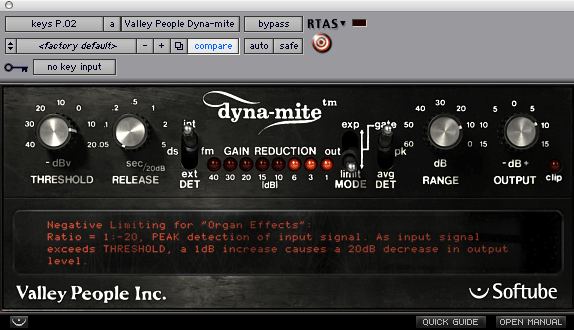 | |
| Dyna-mite GUI For Hammond Organ | Click Here For All Sound Samples |
Vocals
I used the Dyna-mite limiter on a male vocal that was recorded with a very dull sound. I thought to punched up this rather laconic-sounding vocal track. I am compressing harder than is my normal practice but both the producer and I agreed this track could use a little more sonic attitude.
I followed the first Dyna-mite plug-in with another set as a de-esser. This singer (and the recording I inherited) has an "S" problem so Dyna-mite exceeded in taking a lot of the "hiss" out of it. For the final mix, I would probably go ahead and follow this up with a smooth EQ to brighten it up. Softube's Trident A Range EQ Module would be a good choice.
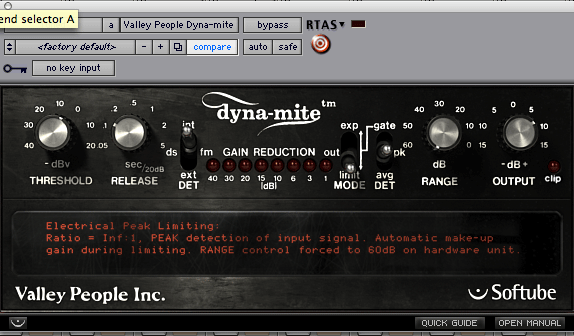 | |
| Dyna-mite GUI For Vocal | Click Here For All Sound Samples |
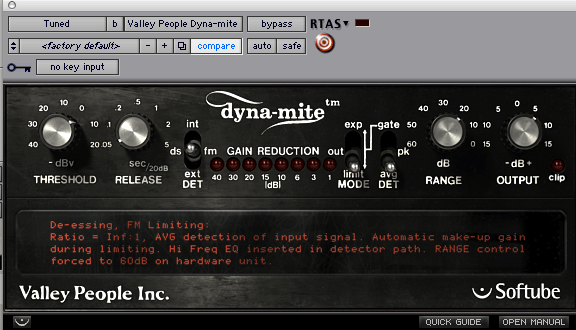 | |
| Dyna-mite GUI For De-Essing Vocal | Click Here For All Sound Samples |
Dyna-mite is Dyn-O-Mite!
Wonderfully arcane and quirky recording/mixing gear is my bailiwick so know that Dyna-mite doesn't disappoint me at all. I like it as much as Softube's brilliant Tubetech CL1-B Compressor plug-in. Dyna-mite promises a lot and delivers more! A big winner here at my Tones 4 $ Studios!
Get more information and download a free trial version at www.softube.com/valleypeople_dynamite.php.
|
|
|